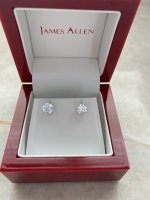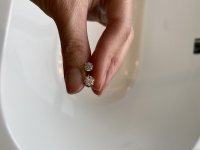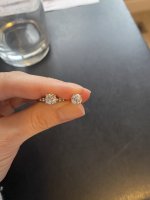I don’t have it yet unfortunately. I expect I’ll have it next month (!!!) and will post if y’all still want to see by then!Can you post a picture of your lab diamond that you purchased from Clean Origin?
You are using an out of date browser. It may not display this or other websites correctly.
You should upgrade or use an alternative browser.
You should upgrade or use an alternative browser.
Lab grown Diamonds - Thoughts?
- Thread starter Minimalist_Chic
- Start date
TPF may earn a commission from merchant affiliate
links, including eBay, Amazon, and others
More options
Who Replied?I own one MMD, a Blue HPHT grown diamond, no other treatment.
Got it because I was curious to see if lab grown Blues are the same in color as natural Blues which I think are gorgeous.
It's .41ct pear, graded by IGI as a fancy intense Blue. It's a pretty stone, but I've have it for going on two years and still haven't
bothered setting it.
It just doesn't make my heart sing the same way natural diamonds do. I don't think I'd get another.
Pics
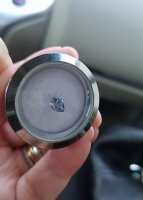

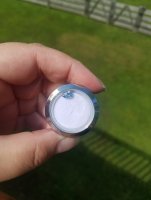
Got it because I was curious to see if lab grown Blues are the same in color as natural Blues which I think are gorgeous.
It's .41ct pear, graded by IGI as a fancy intense Blue. It's a pretty stone, but I've have it for going on two years and still haven't
bothered setting it.
It just doesn't make my heart sing the same way natural diamonds do. I don't think I'd get another.
Pics



I can understand why the blue one didn't work for you--it sort of takes the thrill out of the hunt--and the rarity. However, I'm for lab diamonds. The regular diamond market has been manipulated, with stones being withheld and prices kept artificially higher for decades. If chemically they're the same, and the resale value is awful anyway, why not spend less and get a similar stone? And they *are* diamonds.
Last edited:
They are exactly the same as mined diamonds, the only thing that is different is the source. I would choose lab grown over minded any day due to environmental and price reasons. Can't justify paying £££ more for exactly the same thing. They've come a long way in recent years. I was lucky enough to spend several weeks with a jeweller who specialises in diamonds and makes custom jewellery from cheap to eye watering expensive. His opinion was that the newest lab growns coming on to the market you CANNOT tell the difference even with the highest magnification. The days of cloudy, obviously inferior look are long gone. In fact I got to look at a lot and honestly, on many occasions the lab grown were more beautiful than mine.
Love them!
Love them!
Last edited:
Considering that no one has to die over the lab diamonds, I vote for those.
I just upgraded my mmd 1.42 ctw diamond studs from James Allen to replace my 1.0 ctw mined earrings. They are amazing, so much more sparkle! (I went from uncertified good cut diamonds to ideal cut mmd). When I compare them to my natural stone engagement ring they look just as good and they were a great price!
Attachments
All diamonds are intrinsically beautiful, but I still prefer natural diamonds. Jewelry is an emotional purchase. A huge part of the appeal to me is the idea that you can own a fragment of something marvelous that was growing from the depths of the earth for millions to billions of years. It’s simply amazing to witness something so perfect and yet organic. Crystallization is a miraculous process. It is the literal transformation of chaos into organized structure — the very opposite effect of entropy and decay.
I pretty much only buy designer label jewelry, so I feel very assuaged about the ethics surrounding my purchases because Cartier, VCA, Tiffany, etc. all have extremely stringent standards and offer guaranteed ethical and environmental sourcing for their stones. None of these brands are willing to risk their reputation just to sell a conflict stone of unknown provenance.
Comparatively, I would feel much less confident with buying a generic synthetic diamond that was manufactured in a laboratory. I’m not even aware of what the big synthetic diamond brands are, because I don’t think their consumers really care to know. I would wager that the same consumers who view synthetic and natural diamonds as equal would similarly view synthetic diamonds that came from Laboratory X or Laboratory Y as equivalents. Since synthetic diamonds “sound” more ethical, I think that synthetic diamond manufacturers use that to their advantage when it comes to not disclosing the deeper origins of their products.
On another point, there’s a lack of sentimentalism in lab-grown diamonds. They feel disposable (or fungible) to me in a way that natural diamonds do not. There’s nothing that amazes me or pulls at my heartstrings about growing a diamond in a laboratory for five months. It’s like fast fashion for jewelry. I prefer to have something less commodified. Something that would spark joy in my life if I chose to pass it on to my future kids.
Also, since lab-grown diamonds cost less, I feel that there’s not much attention being placed on how these stones are set, or how lab-grown diamond jewelry is designed. A lot of the jewelry I see with lab-grown stones look very poorly made. The setting, especially, will look awkward or clunky. I’ve so often been able to tell when a piece of jewelry uses CZ or synthetic diamonds, because the product itself looks like it was constructed with cost-savings in mind, instead of with a focus on highlighting the beauty of the stones.
Overall, I don’t have anything against synthetic diamonds per se. They’re cheaper and just as pretty. But I definitely do not prefer them over their natural counterparts. For me, jewelry is so heavily emotional that I find it difficult to be attracted to diamonds just for their sparkle alone.
I pretty much only buy designer label jewelry, so I feel very assuaged about the ethics surrounding my purchases because Cartier, VCA, Tiffany, etc. all have extremely stringent standards and offer guaranteed ethical and environmental sourcing for their stones. None of these brands are willing to risk their reputation just to sell a conflict stone of unknown provenance.
Comparatively, I would feel much less confident with buying a generic synthetic diamond that was manufactured in a laboratory. I’m not even aware of what the big synthetic diamond brands are, because I don’t think their consumers really care to know. I would wager that the same consumers who view synthetic and natural diamonds as equal would similarly view synthetic diamonds that came from Laboratory X or Laboratory Y as equivalents. Since synthetic diamonds “sound” more ethical, I think that synthetic diamond manufacturers use that to their advantage when it comes to not disclosing the deeper origins of their products.
On another point, there’s a lack of sentimentalism in lab-grown diamonds. They feel disposable (or fungible) to me in a way that natural diamonds do not. There’s nothing that amazes me or pulls at my heartstrings about growing a diamond in a laboratory for five months. It’s like fast fashion for jewelry. I prefer to have something less commodified. Something that would spark joy in my life if I chose to pass it on to my future kids.
Also, since lab-grown diamonds cost less, I feel that there’s not much attention being placed on how these stones are set, or how lab-grown diamond jewelry is designed. A lot of the jewelry I see with lab-grown stones look very poorly made. The setting, especially, will look awkward or clunky. I’ve so often been able to tell when a piece of jewelry uses CZ or synthetic diamonds, because the product itself looks like it was constructed with cost-savings in mind, instead of with a focus on highlighting the beauty of the stones.
Overall, I don’t have anything against synthetic diamonds per se. They’re cheaper and just as pretty. But I definitely do not prefer them over their natural counterparts. For me, jewelry is so heavily emotional that I find it difficult to be attracted to diamonds just for their sparkle alone.
Last edited:
Your new earrings are very lovely!I just upgraded my mmd 1.42 ctw diamond studs from James Allen to replace my 1.0 ctw mined earrings. They are amazing, so much more sparkle! (I went from uncertified good cut diamonds to ideal cut mmd). When I compare them to my natural stone engagement ring they look just as good and they were a great price!
BeautifulI just upgraded my mmd 1.42 ctw diamond studs from James Allen to replace my 1.0 ctw mined earrings. They are amazing, so much more sparkle! (I went from uncertified good cut diamonds to ideal cut mmd). When I compare them to my natural stone engagement ring they look just as good and they were a great price!
Very thoughtful post. There seems to be some confusion though regarding Lab grown and synthetic. I wouldn’t classify lab grown as synthetic. Synthetic is more like a pseudo diamond, also man-made but a different material. Lab grown is the exact same material as a real diamond. And of course, you can set any stone into a stunning, quality setting.All diamonds are intrinsically beautiful, but I still prefer natural diamonds. Jewelry is an emotional purchase. A huge part of the appeal to me is the idea that you can own a fragment of something marvelous that was growing from the depths of the earth for millions to billions of years. It’s simply amazing to witness something so perfect and yet organic. Crystallization is a miraculous process. It is the literal transformation of chaos into organized structure — the very opposite effect of entropy and decay.
I pretty much only buy designer label jewelry, so I feel very assuaged about the ethics surrounding my purchases because Cartier, VCA, Tiffany, etc. all have extremely stringent standards and offer guaranteed ethical and environmental sourcing for their stones. None of these brands are willing to risk their reputation just to sell a conflict stone of unknown provenance.
Comparatively, I would feel much less confident with buying a generic synthetic diamond that was manufactured in a laboratory. I’m not even aware of what the big synthetic diamond brands are, because I don’t think their consumers really care to know. I would wager that the same consumers who view synthetic and natural diamonds as equal would similarly view synthetic diamonds that came from Laboratory X or Laboratory Y as equivalents. Since synthetic diamonds “sound” more ethical, I think that synthetic diamond manufacturers use that to their advantage when it comes to not disclosing the deeper origins of their products.
On another point, there’s a lack of sentimentalism in lab-grown diamonds. They feel disposable (or fungible) to me in a way that natural diamonds do not. There’s nothing that amazes me or pulls at my heartstrings about growing a diamond in a laboratory for five months. It’s like fast fashion for jewelry. I prefer to have something less commodified. Something that would spark joy in my life if I chose to pass it on to my future kids.
Also, since lab-grown diamonds cost less, I feel that there’s not much attention being placed on how these stones are set, or how lab-grown diamond jewelry is designed. A lot of the jewelry I see with lab-grown stones look very poorly made. The setting, especially, will look awkward or clunky. I’ve so often been able to tell when a piece of jewelry uses CZ or synthetic diamonds, because the product itself looks like it was constructed with cost-savings in mind, instead of with a focus on highlighting the beauty of the stones.
Overall, I don’t have anything against synthetic diamonds per se. They’re cheaper and just as pretty. But I definitely do not prefer them over their natural counterparts. For me, jewelry is so heavily emotional that I find it difficult to be attracted to diamonds just for their sparkle alone.
Also, just have to comment on the sentimentaliy and uniqueness of diamonds. I pretty much got over that when going to the jewelry mart and seeing literally thousands of diamonds in one day, many of them huge and beautiful. They just seem like another consumer commodity...nothing really special after all except when received as a gift from your life partner.
Very thoughtful post. There seems to be some confusion though regarding Lab grown and synthetic. I wouldn’t classify lab grown as synthetic. Synthetic is more like a pseudo diamond, also man-made but a different material. Lab grown is the exact same material as a real diamond. And of course, you can set any stone into a stunning, quality setting.
Also, just have to comment on the sentimentaliy and uniqueness of diamonds. I pretty much got over that when going to the jewelry mart and seeing literally thousands of diamonds in one day, many of them huge and beautiful. They just seem like another consumer commodity...nothing really special after all except when received as a gift from your life partner.
Synthetic diamonds are chemically the same as diamonds, but they’re grown (or synthesized) in a lab. Synthetic diamonds are diamonds, but they are not produced by nature.
On the other hand, simulated diamonds, or diamond simulants, are stones that are made to resemble diamonds, such as moissanite, white sapphires, or CZ.
Anyways, from the standpoint of engagement rings especially, I’m inclined to think that the vast majority of people would prefer a natural diamond. If given the choice between two stones that are the same price, the same size, and the same quality — just with one being synthetic and the other natural — I think very few consumers would choose the lab-grown diamond. To me, that says that synthetic diamonds are primarily purchased as a budget-friendly substitute to natural diamonds, instead of being viewed as an overall superior product. Despite their technical similarities, the basic essence of a synthetic diamond is not the same as that of a natural diamond.
A diamond ring is a wholly emotional purchase. Unlike clothing or shoes, it is devoid of physical utility. Unlike watches or bags, it doesn’t increase convenience. And unlike houses or food, it doesn’t impact livelihood. Even from the standpoint of proving one’s love, an engagement ring is not necessary to have a wedding proposal or even a successful marriage. Instead, an engagement ring is purchased out of true, abstract desire.
There is simply no physiological justification for buying an engagement ring. And yet, in spite of this fundamental uselessness, diamond rings are still seen as a highly valuable commodity — which means they must provide some type of benefit outside of personal wellbeing or quality of life.
As it turns out, the ring’s value derives from deep personal symbolism and sentimentality. Since that is the case, it is easy to understand why, then, the meaning behind the ring is perhaps the most important purchasing factor.
I think for costumers who prefer natural diamonds, such as myself, the old adage still rings true that, “All that glitters is not gold.” As the diamond ring is supposed to be the symbol of ultimate love, it feels almost wrong to wear something that momentous for the rest of your life if it’s “inauthentic,” or “unnatural.”
That being said, I actually wouldn’t mind a CZ ring or a synthetic diamond ring, so long as it wasn’t being presented to me as a natural diamond. In the end, my feelings toward natural diamonds stem from a love of nature’s grandeur in general. It only reflects a preference. It would be silly for me to reject a proposal over just the ring. There are so many more important things that I care about, and if my SO thinks that our relationship is adequately captured through a CZ ring, then that’s fine. By the time we would be ready to get engaged, I would expect that we would be on the same page about such a significant purchase.
You seem to be confusing the term lab-grown with synthetic. Lab-grown is not a synthetic diamond but is a real diamond produced in a lab...let’s say, high-speed vs low-speed (millions of years). The FTC has ruled that to call a lab-grown diamond synthetic is misleading as the chemical composition is exactly the same. You do not have yo worry about the sketchy and exploitative mining practices or a company’s deceptive labeling of a diamond as conflict free. I don’t own any lab-grown diamonds but would definitely consider them if I were interested in buying more diamonds.Synthetic diamonds are chemically the same as diamonds, but they’re grown (or synthesized) in a lab. Synthetic diamonds are diamonds, but they are not produced by nature.
On the other hand, simulated diamonds, or diamond simulants, are stones that are made to resemble diamonds, such as moissanite, white sapphires, or CZ.
Anyways, from the standpoint of engagement rings especially, I’m inclined to think that the vast majority of people would prefer a natural diamond. If given the choice between two stones that are the same price, the same size, and the same quality — just with one being synthetic and the other natural — I think very few consumers would choose the lab-grown diamond. To me, that says that synthetic diamonds are primarily purchased as a budget-friendly substitute to natural diamonds, instead of being viewed as an overall superior product. Despite their technical similarities, the basic essence of a synthetic diamond is not the same as that of a natural diamond.
A diamond ring is a wholly emotional purchase. Unlike clothing or shoes, it is devoid of physical utility. Unlike watches or bags, it doesn’t increase convenience. And unlike houses or food, it doesn’t impact livelihood. Even from the standpoint of proving one’s love, an engagement ring is not necessary to have a wedding proposal or even a successful marriage. Instead, an engagement ring is purchased out of true, abstract desire.
There is simply no physiological justification for buying an engagement ring. And yet, in spite of this fundamental uselessness, diamond rings are still seen as a highly valuable commodity — which means they must provide some type of benefit outside of personal wellbeing or quality of life.
As it turns out, the ring’s value derives from deep personal symbolism and sentimentality. Since that is the case, it is easy to understand why, then, the meaning behind the ring is perhaps the most important purchasing factor.
I think for costumers who prefer natural diamonds, such as myself, the old adage still rings true that, “All that glitters is not gold.” As the diamond ring is supposed to be the symbol of ultimate love, it feels almost wrong to wear something that momentous for the rest of your life if it’s “inauthentic,” or “unnatural.”
That being said, I actually wouldn’t mind a CZ ring or a synthetic diamond ring, so long as it wasn’t being presented to me as a natural diamond. In the end, my feelings toward natural diamonds stem from a love of nature’s grandeur in general. It only reflects a preference. It would be silly for me to reject a proposal over just the ring. There are so many more important things that I care about, and if my SO thinks that our relationship is adequately captured through a CZ ring, then that’s fine. By the time we would be ready to get engaged, I would expect that we would be on the same page about such a significant purchase.
You seem to be confusing the term lab-grown with synthetic. Lab-grown is not a synthetic diamond but is a real diamond produced in a lab...let’s say, high-speed vs low-speed (millions of years). The FTC has ruled that to call a lab-grown diamond synthetic is misleading as the chemical composition is exactly the same. You do not have yo worry about the sketchy and exploitative mining practices or a company’s deceptive labeling of a diamond as conflict free. I don’t own any lab-grown diamonds but would definitely consider them if I were interested in buying more diamonds.
I’m not confused. My understanding remains the same. A lab-grown diamond is, indeed, referred to as a synthesized diamond.
“Synthetic diamond” is the appropriate term for a diamond that was cultured in a laboratory. You’re confusing “synthetic” with “simulant.”
@sosauce is correct. Lab grown diamonds are referred to as synthetic diamonds and simulants are made of non-diamonds materials (CZ, moissanite, etc.).
FTC does not permit referring to lab-grown diamonds as synthetic so that’s good enough for me. FTC regulates consumer products and protects consumers. The term synthetic is very misleading and indicates a false, non-authentic product, hence the change in terminology.
Register on TPF! This sidebar then disappears and there are less ads!

